从天而降 改变了英语的英国馅饼
来源:BBC Learning English 作者:诺曼·米勒(Norman Miller) 更新:2023年5月7日
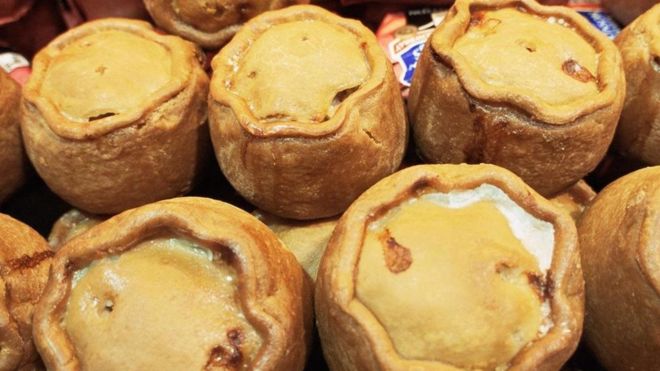
每年三月,莱斯特郡(Leicestershire)梅尔顿莫布雷镇(Melton Mowbray)的圣玛丽教堂(St Mary's)都会成为馅饼的圣地,里面摆满桌子,上面摆放着800多种点心。
一些品种特别离奇。虽然今年的"特殊肉类"(Speciality Meat)中最诡异的一种是蟋蟀派(cricket pie),但是往年的优胜者中知名的一个是2014年菲尔·沃姆斯利(Phil Warmsley)的松鼠派。沃姆斯利告诉我,这种派起源于中世纪,但仍然会在马基特哈伯勒(Market Harborough)两周一次的农贸市场销售一空。 "它们也是处置有害生物的好办法",他笑道。
不仅仅是松鼠派:几百年前,许多种类的馅饼就已经是英国美食中深受喜爱的部分。十一世纪有记载显示,东安格利亚(East Anglia)以鲱鱼派向国王缴纳赋税——这种做法持续了800多年,各城镇都要求缴纳 "由100只鲱鱼烤制的24个酥皮馅饼"作为每年的贡物。
1429年亨利六世(Henry VI )加冕仪式的记载中提到一个称为"孔雀馅饼"(Partryche and Pecock)豪华馅饼,而1465年为庆祝新的约克大主教(Archbishop of York)就任举行的盛宴则让客人们饱餐了5500只鹿肉馅饼。英国历史上伟大的艺术家威廉·荷加斯(William Hogarth)在他1750年的画作《向芬奇利的进军》(The March to Finchley)中,将一位街头馅饼摊贩置于画面中央。
即使在早期,对富人和穷人而言馅饼也有不同的用途:对前者而言是用以炫耀的美味佳肴,对后者则是便于携带的食物。所以虽然富人的宴席可能囊括了从猎禽到贻贝等各式各样的馅料,不太富裕的人却把简易的馅饼作为一种在户外劳作或旅行时果腹的方式——馅饼的外皮使之既方便携带又保留了馅料的美味。
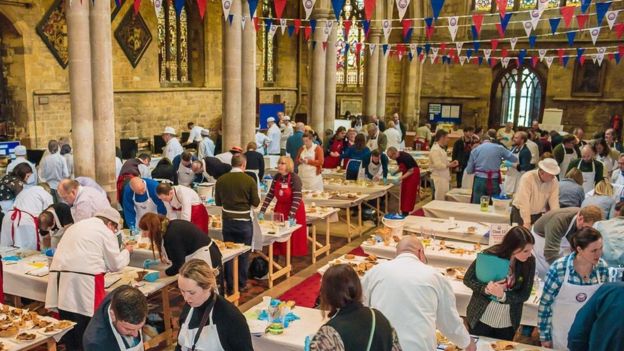
一年一度,梅尔顿莫布雷的圣玛丽教堂都会成为英国派大奖赛(British Pie Awards)的举办地(图片来源: Alamy)
以贝德福德郡瘦长形羊酥饺(Bedfordshire Clanger)为例,它是一种将主菜和甜点巧妙结合在一起的经典英国菜,一端填充可口开胃的馅料如猪肉,而另一端则佐以像梨子这样的甜品。 这个名字来自当地的一个俚语,"clang",意思是狼吞虎咽。 然而,将两种馅料填充进同一只派会使其笨重而不易操作, 而且太容易掉下来,于是就演绎出了表达粗心大意而犯错的英语短语"dropping a clanger"(意思是"当众失言")。
几个世纪以来,派一直为英语增添丰富的韵味。 即使是莎士比亚(Shakespeare),也在他1613年的剧目《亨利八世》中写道:"没有任何人的派能逃离他野心勃勃的手指"("No man's pie is freed from his ambitious finger"),于是就给英文引进了一个短语"a finger in every pie" ("在每个派里都粘一指头")。(意思是参与了很多不需要参与的事情)
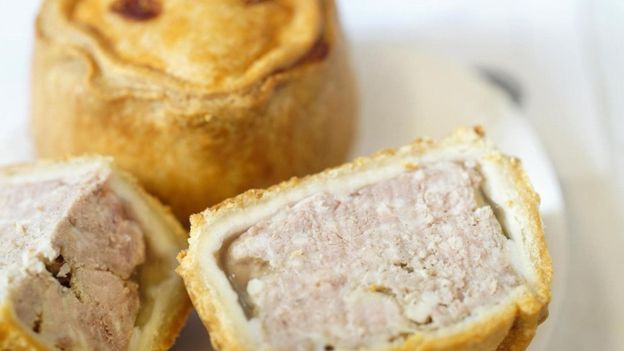
英国最传统的馅饼之一是梅尔顿莫布雷的猪肉派,它甚至被授予欧盟产地保护地位(图片来源: British Pie Awards)
同时,醉酒状态被形容为"pie-eyed"("派眼大睁"),很可能是由某个过度饮酒的人那里引申而来,这人眼睛大张而空洞,好像馅饼顶部的开口一样。短语"As easy as pie" ("像馅饼一样简单",意思是极容易),它首次在1886年的赛马报《体育生涯》(Sporting Life)中被记载为"like eating pie"("就像吃馅饼"),源自馅饼作为方便食物的历史角色。
与此同时,"Eating humble pie"("食用谦卑的馅饼")来自中世纪的猎鹿活动,当时猎来的肉是以社会地位尊卑来进行分配的。最好的鹿肉分给权贵,而下等人只能得到"nombles",这是诺曼法语(Norman French)中表示鹿内脏的词汇。 "内脏"派英语化后成为"谦卑的"派。
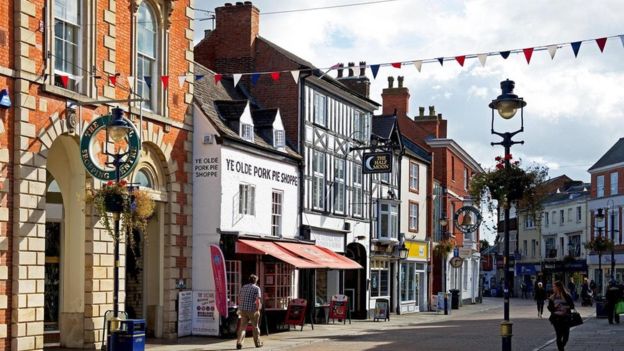
莱斯特郡的梅尔顿莫布雷镇在英国因馅饼而闻名遐迩(图片来源:Alamy)
除了改变英语,馅饼本身也已成为文化财富。
2008年,欧盟授予梅尔顿莫布雷猪肉派"地理标志保护"(PGI)——与香槟具有同样的卓著地位。 梅尔顿卡内基博物馆(Melton Carnegie Museum)解释了这个来自诺曼人集市小镇的馅饼是怎样发展到具有如此声望:特别是当地的猪狂热喜爱当地同样知名的斯蒂尔顿奶酪(Stilton cheese)制作之余的乳清,导致当地许多农民饲养并食用这种牲畜。 其结果是将切碎的猪肉放入馅饼中烹熟后再冷食。这些成为了17世纪以来广受该地区大型猎狐兄弟会以及当地农场工人欢迎的马背餐。

梅尔顿莫布雷镇附近的农田数量使得该地区成为猪的理想饲养地,同时也是猪肉馅饼的绝佳产地(图片来源:Alamy)
在约克郡的丹比戴尔(Denby Dale)可以发现另一项传统带来的财富,这里是巨型馅饼的世界之都。该村1788年为纪念乔治三世(George III)从一场疯癫发作中清醒过来而烤制了它的第一个巨型馅饼,尽管遗憾的是关于其大小或佐料成分没有书面记录。此后,该村烤制了九个"巨型派"。 1815年,为庆祝打败拿破仑(Napoleon)烤制了"胜利派"(Victory Pie),共用了两只羊和20只家禽;而2000年的"千禧派"(Millennium Pie)则长达12米,重10吨。
派为英国精英们提供的炫耀方式不仅仅是尺寸。 16世纪和17世纪,所谓的"惊喜派"(Surprised Pyes)风靡一时,烤成后额外添加的可拆卸的酥皮盖子下面掩藏意想不到的东西,这样的派给贵族宴会上的宾客留下了深刻印象。
16世纪制作的一个巨型皇家派里隐藏着一队音乐家,他们在切馅饼的时候开始演奏,另一个伎俩就是有人冲破饼皮开始吟诵诗歌。把活着的鸟藏在派里也很受欢迎——因此就有了童谣《唱一首六便士之歌》(Sing a Song of Sixpence)中的"二十四只乌鸫"('four and twenty blackbirds')。
在大奖赛中"区域派类"(Regional Pie)表明馅饼不仅仅标明一个人的社会地位,也标志了英国不同地区的食物。今年的冠军是诺福克犁布丁(Norfolk Plough Pudding),它是用香肠肉,培根,鼠尾草,洋葱和黄糖制成的。这种馅饼在东安格利亚那带是传统食物,在主显节(Epiphany)之后的第一个星期一,当春天耕种就要开始时烤制。
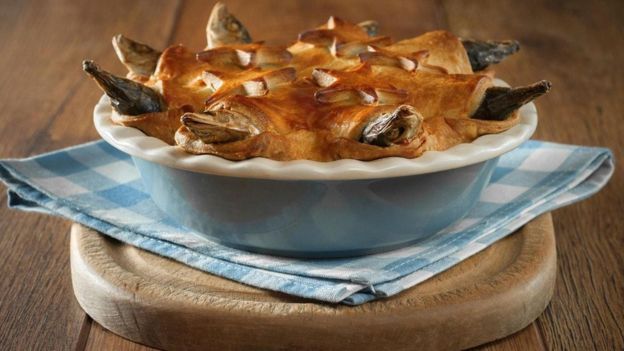
这种沙丁鱼点心可能是英国最引人注目的馅饼,可追溯回17世纪(图片来源:Alamy)
但康沃尔郡(Cornwall)引人注目的仰望星空派(Stargazy Pie)可能是最与众不同的。这种馅饼用沙丁鱼烹制,鱼从派的外皮向外抬头凝望着,这种独特的馅饼,起源于一个17世纪毛斯合尔(Mousehole)渔村的故事。故事讲述一位名叫汤姆·鲍科克(Tom Bawcock)的渔夫勇敢地冒着十二月的风暴,捕获了一大拖网的鱼拯救了饥饿的村庄。为了庆祝,他的收获被烘烤成一个巨大的庆祝派 ——留下的鱼头伸出派,表明鱼荒已经结束了。今天,仰望星空派用七种鱼,煮土豆,煮鸡蛋和白汁沙司的传统方式烤制。鱼不仅仅具有象征性,还有实际的目的:鱼头的油脂让糕饼口味丰富也滋润了饼皮。
如果这听起来有点古怪又有趣,那你就没弄错。而在二十一世纪,这可能是延续馅饼传统的最好理由之一。正如凯文·阿什比牧师(Reverend Kevin Ashby)在传统的英国派大奖赛(British Pie Awards)为馅饼祝福之后说:"我们必须有派。在派的面前压力并不存在!"
How a pocket-sized snack changed the English language
Every March, St Mary’s church in the Leicestershire town of Melton Mowbray becomes a cathedral of pies: it fills with tables bearing more than 800 pastries.
Some recipes are particularly offbeat. While the quirkiest entry in this year's Speciality Meat category was a cricket pie, one celebrated past winner was Phil Walmsley's squirrel pie in 2014. Walmsley told me that it has medieval origins, but still sells out at Market Harborough’s twice-monthly farmers’ market. “They're also a great way to deal with a pest,” he laughs.
It’s not just the squirrel pie: several hundred years ago, there were many types of pies already a beloved part of British cuisine. Records from the 11th Century show East Anglia paying levies to the Crown with herring pies – a practice that continued for 800 years – with towns required to send an annual tribute of “100 herrings baked in 24 pasties”.
Records of Henry VI’s 1429 coronation speak of a suitably regal pie of ‘Partryche and Pecock’, while the 1465 feast for the new Archbishop of York saw guests scoff 5,500 venison pasties. The great artistic chronicler of English life, William Hogarth, puts a street pie seller centre-stage in his 1750 painting The March to Finchley.
Even in their early days, pies served different purposes for the rich and poor: as show-off delicacies for the former and portable food for the latter. So while wealthy feasts might include pies containing anything from game birds to mussels, the less well-off used simpler pies as a way to have food while doing outdoor work or travelling – the crust both carried and preserved the tasty filling.
Take, for example, the Bedfordshire Clanger: a British classic which cleverly combines main course and dessert, with savoury ingredients like pork at one end and sweet ingredients like pear at the other. The name comes from a local slang word, ‘clang’, which means to eat voraciously. However, cramming two courses into a pie makes a clanger rather unwieldy – and all too easy to drop, inspiring the English phrase 'dropping a clanger' for a careless mistake.
Pies have been adding rich flavour to the English language for centuries. Even Shakespeare got in on the act, writing in his 1613 play Henry VIII that “No man’s pie is freed from his ambitious finger”, giving English the phrase 'a finger in every pie'.
Meanwhile, the description of a drunken state as ‘pie-eyed’ likely takes its cue from someone who, thanks to having over-imbibed, has eyes as wide and blank as the top of a pie. ‘As easy as pie’ – first recorded as 'like eating pie' in the horse-racing newspaper Sporting Life in 1886 – springs from pies’ historical role as convenience food.
‘Eating humble pie’, meanwhile, comes from medieval deer hunting, when meat from a successful hunt was shared out on the basis of social status. While the finest cuts of venison went to the rich and powerful, the lower orders made do with the ‘nombles’: a Norman French word for deer offal. Anglicisation saw ‘nombles’ pie become ‘humble’ pie.
As well as changing the English language, pies have become a cultural treasure in their own right.
In 2008, the European Union gave Melton Mowbray's pork pies ‘protected geographical indication’ (PGI) – the same elite status as Champagne. The Melton Carnegie Museum explains how the pies from this Norman market town developed such fame: pigs in particular had a taste for the whey left over from making the equally-renowned local Stilton cheese, leading to many local farmers keeping – and eating – the animals. This resulted in the chopped pork which was put into the pie, cooked and then eaten cold. These became popular horseback meals for the area’s large fox-hunting fraternity from the 17th Century onwards, as well as for local farm workers.
Another treasure of a tradition can be found in Yorkshire's Denby Dale, which is the world capital of giant pies. The village baked its first mammoth creation in 1788 to mark George III's recovery from a bout of madness, though sadly there is no written record of its size or ingredients. Since then, nine ‘megapies’ have been created. The 1815 Victory Pie celebrated the defeat of Napoleon with a pie containing two sheep and 20 fowls, while the Millennium Pie of 2000 was 12m long and weighed 10 tonnes.
Pies have provided a way for the British elite to show off with more than just size. The 16th and 17th Centuries saw the rise of so-called Surprised Pyes, created to impress guests at aristocratic banquets by concealing unexpected things under an additional removable pastry lid added after cooking.
One gigantic 16th-Century royal pie concealed a gaggle of musicians who began playing when the pie was cut, while another trick saw people burst out of a pie to recite poetry. Concealing live birds was also popular – hence the ‘four and twenty blackbirds’ in the nursery rhyme Sing a Song of Sixpence.
The Regional Pie category at the Awards acknowledges how pies are edible markers of not only one’s social status, but of different British regions. This year's winner was a Norfolk Plough Pudding, made with sausage meat, bacon, sage, onion and brown sugar. It’s traditionally baked in that part of East Anglia for the first Monday after Epiphany, when spring ploughing is meant to begin.
But it was Cornwall’s eye-catching Stargazy Pie that might be the most distinctive. Cooked with sardines gazing up from the crust, this distinctive pie has roots in a 17th-Century tale from the fishing village of Mousehole. The story goes that a fisherman named Tom Bawcock braved December storms to land a huge haul of fish that saved the village from starvation. To celebrate, his catch was baked into a giant celebratory pie – with fish heads left poking out as proof that the fish famine was over. Today, Stargazy Pie is traditionally baked with seven kinds of fish, boiled potatoes, boiled eggs and white sauce. The fish serve a practical purpose, not just a symbolic one: oil from the heads enriches the pastry and moistens the pie.
If that sounds somewhat quirky and fun, you’re not mistaken. And in the 21st Century, that may be one of the best reasons to continue the pie tradition. As Reverend Kevin Ashby puts it after his blessing of the pies, a tradition of the British Pie Awards: “We must have pies. Stress can’t exist in the presence of a pie!”